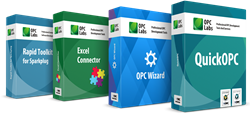Comparison of OPC UA complex data models
From OPC Labs Knowledge Base
OPC UA offers two complex data models. They do not have "official" names, but the historically first one is based on the DataTypeDictionary type, and the second one is based on the DataTypeDefinition type. We will therefore usually refer to them as "DataTypeDictionary model" (or "data type dictionary model"), and "DataTypeDefinition model" (or "data type definition model").
The table below summarizes the main difference between the two models.
| DataTypeDictionary Model | DataTypeDefinition Model | ||
|---|---|---|---|
| OPC UA version | 1.00 and later (deprecated in 1.04 and later, but still available) | 1.04 and later | |
| Described in | OPC UA Specification Part 5 (Information Model) | OPC UA Specification Part 3 (Address Space Model) | |
| Compatible with OPC UA Client-Server | yes | yes | |
| Compatible with OPC UA PubSub | no | yes | |
| Complexity of implementation, and number of OPC UA operations needed to work with the model | high | somewhat lower | |
| Extensibility | Two "data type systems" (how are data types described, and their resulting encoding) are defined by OPC Foundation (OPC Binary data type system, and XML Schema data type system). In theory, anybody can add new data type systems, but we do not know of any being already defined, and it is very unlikely that they ever will. | Not extensible (besides the fact that any OPC UA encoding defined becomes supported under this model). | |
| OPC Binary Data Type System | XML Schema Data Type System | ||
| How are data types described | using a XML document conforming to OPC Binary XML schema defined by OPC Foundation | using XML Schema (commonly referred to as XSD), defined by W3C | using OPC UA structures |
| Resulting encoding | Binary | XML | any encoding defined in OPC UA (Binary, XML, JSON) |
| Suitable for small devices | yes | usually no (XML schema is too big) | yes |
| Can refer to data types in other servers | yes | yes (details not specified) | no |
| Data type inheritance | no | no | yes |
| Selectable byte order | yes | no | no |
| Simple data types | yes | as per XML Schema capabilities | yes |
| Ability to specify maximum string length | no | yes | |
| Opaque data types with bit-sized granularity | yes | no | |
| Enumerated data types | yes | yes | |
| Structured data types | yes | yes | |
| Structured data types with optional fields based on simple boolean presence flag | yes (using switch fields) | yes (directly) | |
| Structured data types with optional fields based on more complex conditions | yes | no | |
| Sequences and one-dimensional arrays with given length | yes | yes | |
| Sequences with specified termination pattern | yes | no | |
| Multi-dimensional arrays | need to be modeled as sequences of sequences | directly supported | |
| Supported in QuickOPC | Version 2018.1 and later | no | Client-Server, binary encoding: Version 2020.2 and later |
